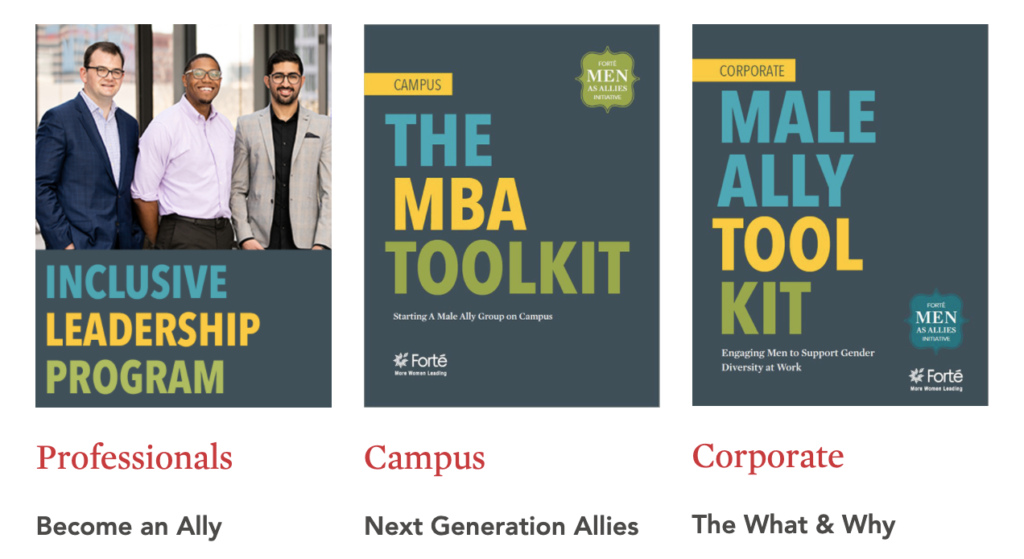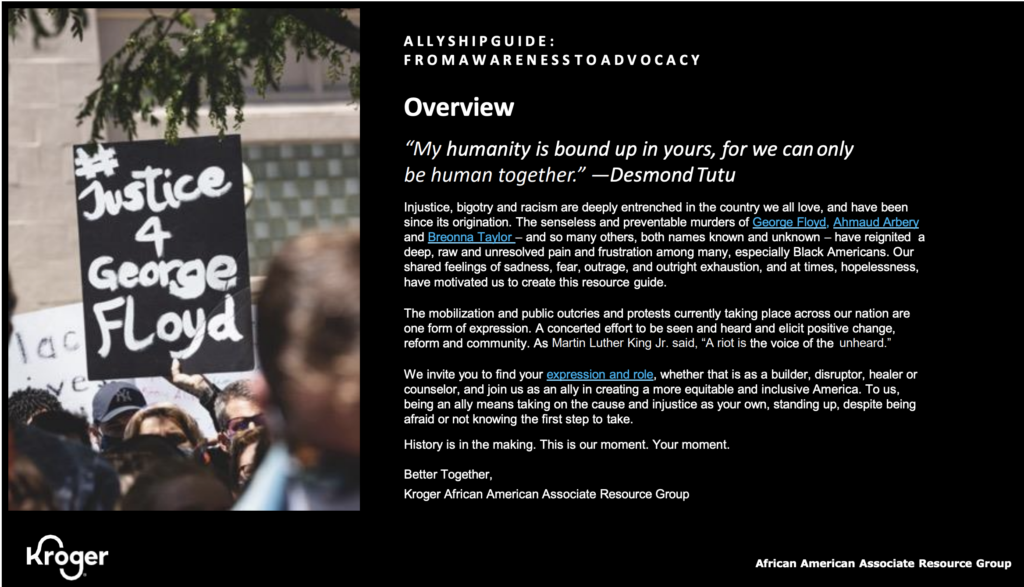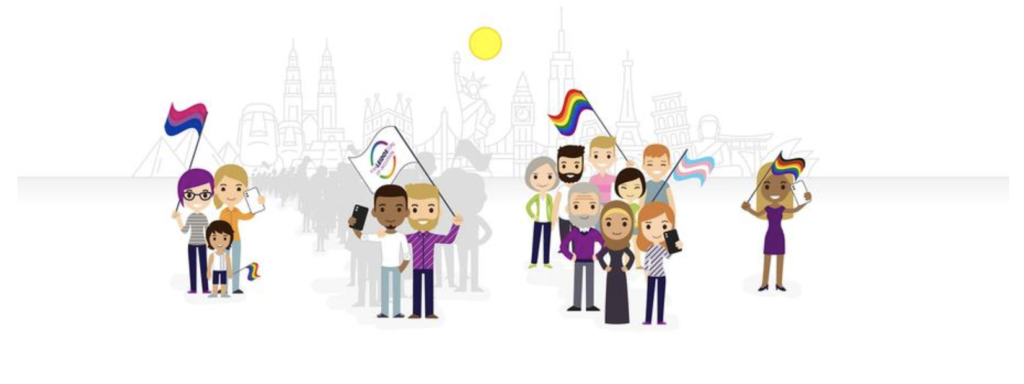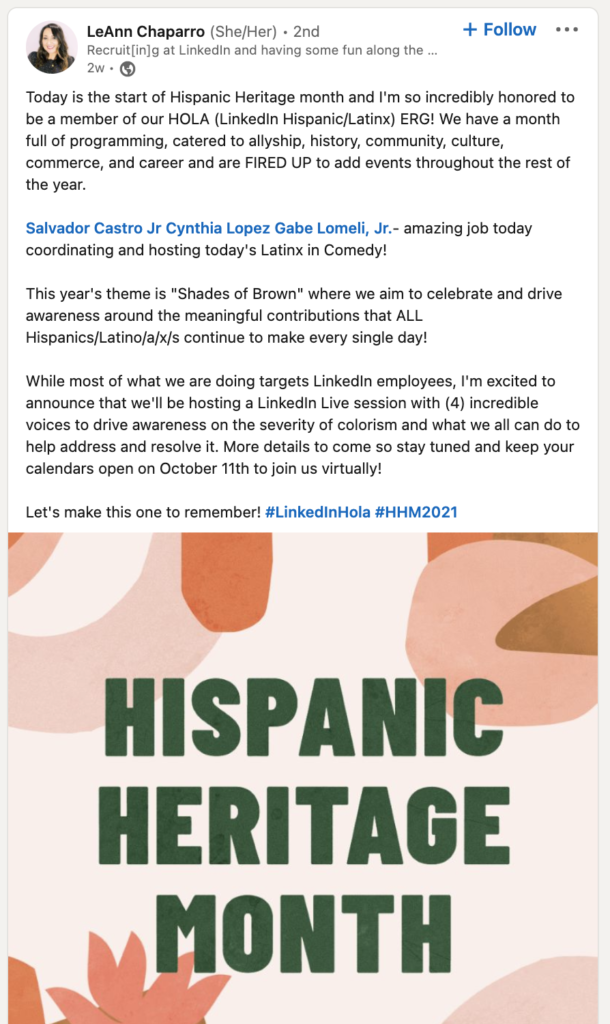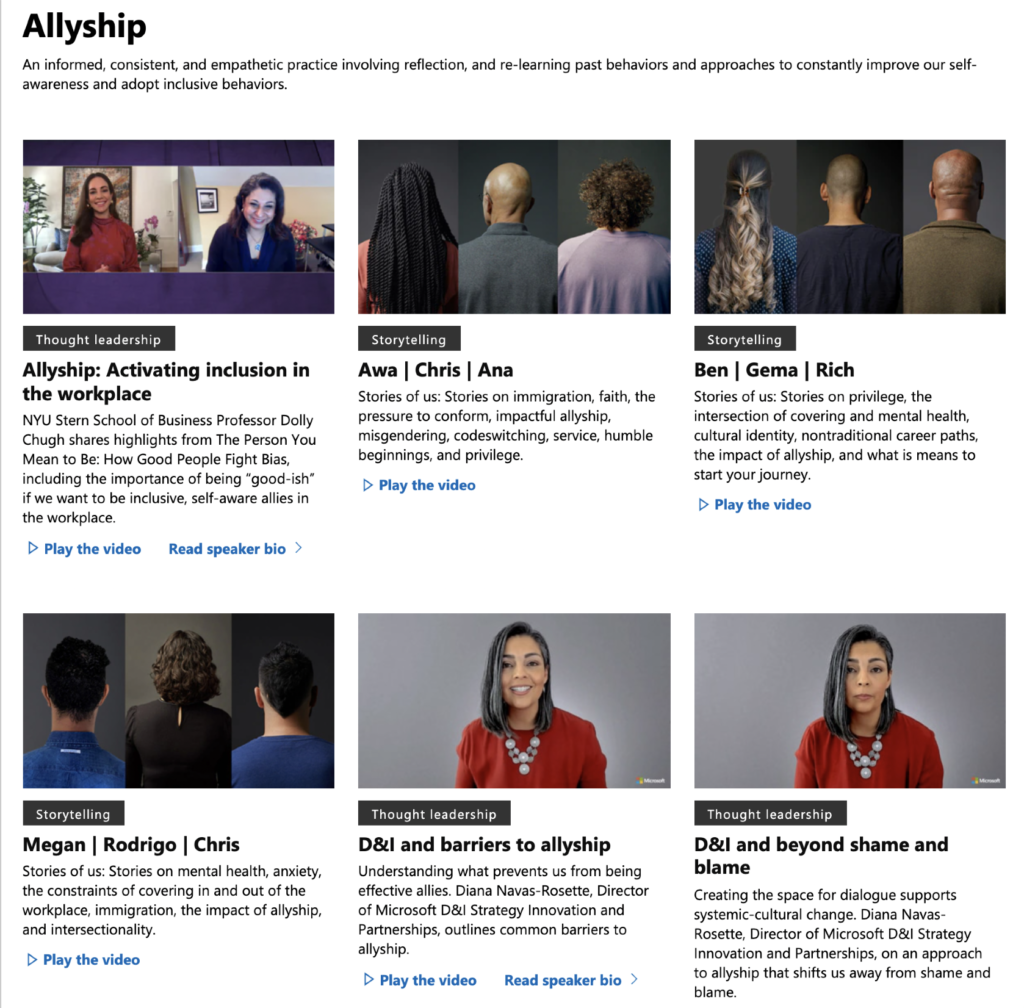- 16 Helpful Career Site Self-Service Tools for You - December 18, 2025
- Last Week I Had a Viral LinkedIn Post — But Why? (And What TA Folks Can Learn From It) - December 8, 2025
- Job Description Process Improvement: How One Workflow Fix Saved 1,200 JDs from Chaos - December 4, 2025
How can you build allyship in the workplace? I found 7 examples of companies doing just that. But before we dive in, here’s what it means to be an ally at work.
What is allyship in the workplace?
Being a good ally means you accept the privilege majority groups have in a professional setting and use it to help break down systems keeping your co-workers from having the same opportunities.
Many companies (like Microsoft) now require mandatory allyship training, workplace activities focused on how to be an ally to marginalized communities, and seminars on effective allyship.
Not all businesses are making ally groups mandatory, but here are 7 examples of what some are doing:
Forté’s Male Allies Program
In 2016, Forté launched the “Men as Allies” initiative on 10 business school campuses; the number grew to 41 schools in 3 years.
Elissa Sangster, Forté CEO, says the goal of Men as Allies is:
“to help male students benefit from, and get involved in, enhancing gender equity on campus and to take that experience back to the business world”
In 2018, Forté partnered with PNC Financial Services to take the male allies program to companies like Kaiser Permanente, Webster Bank, and Toronto-Dominion Bank.
In 2020, Forté hosted effective allyship sessions with featured guests:
- Brad Johnson and David Smith — co-authors of Good Guys: How Men Can Be Better Allies to Women in the Workplace and Athena Rising: How and Why Men Should Mentor Women
- Julie Kratz — speaker, inclusive leadership trainer, podcast host, and author of Lead Like An Ally
- Joshua Stewart — Senior Vice President, Director of Talent Soultions, Outreach & Accessibility at PNC
- Ericka Young — Speaker, author, financial coach at Tailor-Made Budgets
(source: How Forté’s Men as Allies Program is Helping Top Companies Support Women — by Lisa Beebe)
Johnson & Johnson’s LBGTQ Allyship Initiative
Johnson & Johnson is supporting LGBTQ allyship with their “broad-based educational initiative to increase awareness and dialogue around allyship, in connection with microaggressions, within and for our LGBTQIA+ community.”
J&J’s allyship program is led by:
- Renée Evans — Learning Management Systems Team Lead
- Glenn Wrightington — Sr. NPI Supply Chain Planning Analyst
- Tiffany Boyer — Sales & Distributor Services Procurement Category Associate
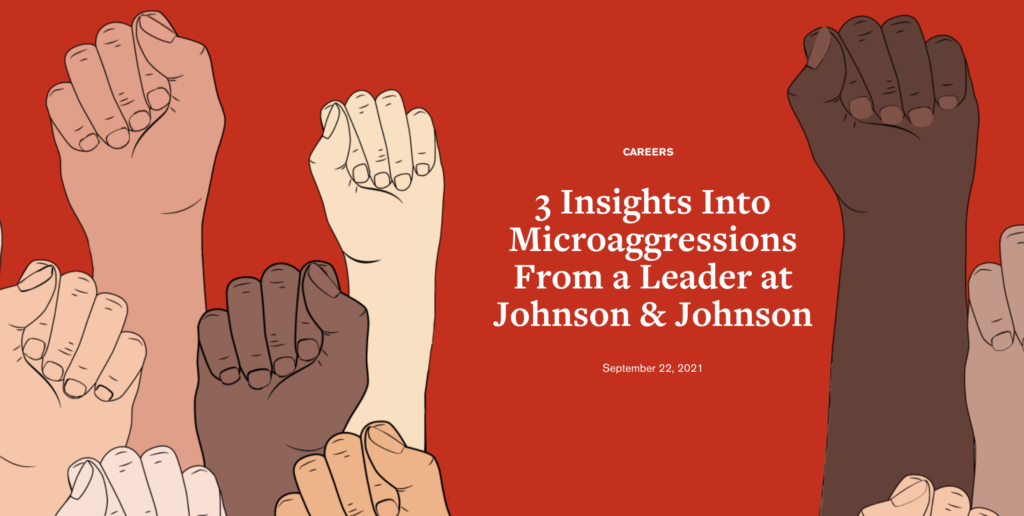
Renée’s goal is to elevate conversations around microaggressions and allyship in the workplace. She says this on J&J’s career page:
“Whether it’s through your manager, HR, Open&Out—our Employee Resource Group for the LGBTQIA+ community—or the Office of Diversity, Equity and Inclusion, we have channels for individuals to go through so that they can continue to learn. Everyone across our entire organization needs to know that this is an inclusive, safe place. And at the end of the day, we’re all still learning.”
Glenn also weighs in, saying:
“My passion for this training stems from conversations with colleagues and family about my involvement with Open&Out, where a reoccurring comment I heard was, ‘I wouldn’t know what to do.’ I realized that there could be many other allies hiding behind that same comment and afraid to step out. Once we launched this initiative, we also realized we needed to expand globally with translations and updates to reflect regional laws and safety. We want to ensure that everyone can bring their best self to the workplace.”
(source: 3 Insights Into Microaggressions From a Leader at Johnson & Johnson)
Kroger’s Resource Group for Black Allies
Kroger offers effective allyship guides to support LGBTQ+ and Asian American Pacific Islander employees. The guide on becoming Black allies (From Awareness to Advocacy) written by the African American Associate ERG focuses on:
- how to be an ally for social justice
- advice on supporting Black colleagues
- allyship diversity terms to know
- book, podcast, and movie recommendations discussing race
(source: What Does Being an Ally Look Like? Companies Offer Training in Support of Black Colleagues — by Patrick Thomas)
Leidos’ Ally Groups for Underrepresented Groups
Leidos has 9 employee resource groups (ERGs) with 3,000+ members. These groups host allyship activities and events to:
“push for equality, it is crucial to understand what it means to stand up for marginalized communities.”
Leidos’ ERG page also lists the benefits of being a good ally:
— You are improving the system for others, as well as yourself.
— You open yourself up to the possibility of close relationships with others.
— You become less locked into stereotypes.
— You have opportunities to learn from, teach, and have an impact on a population with whom you might not otherwise interact.
— You can make a profound difference in the lives of others
(source: Allyship: What it means and how to get involved)
LinkedIn’s Allyship Activities for Hispanic Heritage Month
September 15th to October 15th is Hispanic Heritage Month. To celebrate, LinkedIn’s Hispanic/Latinx ERG “HOLA” is creating awareness on how to be an ally to marginalized communities. LeAnn Chaparro, a Senior Recruiter at LinkedIn, explains her excitement for these upcoming events on how to be an ally (& more):
(source: LinkedIn Hispanic Heritage Month)
Microsoft’s Effective Allyship Program
In 2019, Microsoft launched its “global allyship program.” In 2020, they made it virtual AND mandatory for all employees. The reason:
“amid the global chaos of 2020 — including a pandemic requiring remote work and making relationships more challenging, acts of hate toward those with Asian heritage stemming from false rhetoric about the virus, widespread protests against racial injustice following violence against Black and African American people, and increased political tensions.”
The program includes 10 segments in various media appealing to different learning styles. Chief Diversity Officer Lindsay-Rae McIntyre says the goal of their allyship in the workplace program is to:
“give Microsoft’s 160,000 employees worldwide the language they need to discuss different viewpoints and difficult things in a way that offers empathy and inclusion to all.”
(source: A different kind of diversity program is inspiring people to be better allies – and be OK with making mistakes — by Susanna Ray)
RingCentral’s LGBTQ/Trans Allyship Group
What does it mean to be an ally to LGBTQ communities? RingCentral creates multiple opportunities for LGBTQ+ allyship in the workplace.
One ally example is the release of their “employee signature templates” that allow employees to use their preferred personal pronouns:
Other allyship activities at RingCentral include:
- creating the “Rainbow Room,” an ERG for LGBTQ allies and employees
- celebrating Transgender Awareness week to help build trans allyship
(source: 31 Companies With Impactful Initiatives to Support Their LGBTQ Employees — by Danielle Agugliaro)
Google’s Allyship in Action Program
Google’s ally program is aimed at antiracism. The program has training workshops, speaker sessions, and a learning focus on critical race theory. In one session called “Allyship in Action” a group of trainers including Google’s head of systemic allyship Randy Reyes and consultants from The Ladipo Group, ask employees to:
“confront their ‘power and privilege’ and rank themselves according to their racial background and sexual orientation.”
(source: Yahoo! News)
Liberty Mutual Sponsored “Allyship” DEI Festival
In 2021, Liberty Mutual was a gold sponsor for an allyship-themed DEI festival for the insurance industry. The Dive In 2021 theme was “active allyship” and the sessions covered topics from LGBTQ+ to neurodiversity, generational differences, the work-life balance, mental health, and others.
Here’s what Liberty Mutual VP & Director, Global Office of Diversity, Equity & Inclusion, Mariana Fagnilli, said about this allyship event:
“I think the Dive In festival is truly phenomenal in that it’s an opportunity to bring industry competitors together behind shared objectives. DE&I is something that we all need to do better at for the sake of our industry, our employees, and our customers. At Liberty Mutual, we see this as an opportunity, we see the need, and we’re very excited to work with Dive In to bring everyone together and help build a better industry for all.”
source: Insurance Business America
Liberty Mutual has also launched Men as Allies and Pride at Liberty ERGs to support allyship.
The 7 A’s of Allyship
Each of the co.s above hone in on at least 1 (or more) of the “7 A’s of Allyship” in their programs to be true allies at work. Here’s a list of the 7A’s (plus a great video giving each some context):
- Action
- Assume
- Apologize
- Acknowledge
- Accept
- Ask
- Appetite
Ways to be an ally at work
Creating a workplace where everyone feels respected and supported is crucial for a positive work environment. So, being an ally at work means actively standing up for and supporting your colleagues, especially those from underrepresented or marginalized groups. Here are some simple ways you can be a better ally:
- Educate Yourself:
Take the initiative to learn about different cultures, identities, and experiences. So, read books, listen to podcasts, or attend workshops to broaden your understanding.
- Listen Actively:
Practice active listening when your colleagues share their experiences or concerns. Make sure they feel heard and validated.
- Use Inclusive Language:
Be mindful of the words you use and avoid language that may be exclusionary or offensive. So, use inclusive terms that respect people of all genders, races, and backgrounds.
- Speak Up:
If you witness discriminatory practices or hear inappropriate comments, speak up and address them respectfully. Don’t be afraid to advocate for change.
- Support Diversity Initiatives:
Get involved in workplace diversity initiatives and support efforts to create a more inclusive environment. So, offer your time, resources, or expertise to help these initiatives succeed.
- Be an Active Bystander:
If you see someone being treated unfairly, intervene in a safe and appropriate manner. Stand up for your colleagues and support them in difficult situations.
- Check Your Privilege:
Reflect on your own privilege and how it may impact your perspectives and experiences. Use your privilege to amplify the voices of those who may not have the same opportunities.
- Mentor and Sponsor Allies:
Offer mentorship and sponsorship opportunities to colleagues from underrepresented groups. Help them navigate their careers and advocate for their advancement.
- Continue Learning and Growing:
Allyship is an ongoing process. Stay informed about current issues and continue to educate yourself on ways to be a better ally.
- Create a Culture of Allyship:
Encourage open dialogue and create a safe space where everyone feels comfortable sharing their experiences and perspectives. Foster a workplace culture that values diversity and inclusion.
Remember, being an ally is about taking action and making a difference in the lives of your colleagues. By practicing allyship, you can help create a more equitable and inclusive workplace for everyone.
What makes Allyship at Work effective
Allyship isn’t just a buzzword; it’s a powerful tool for creating positive change in the workplace. But what makes allyship truly effective?
Creating a Safe Space:
Effective allyship starts with creating a safe space where all team members feel valued and respected. This means actively challenging discriminatory practices and fostering an environment of inclusion.
Active Listening and Open Dialogue:
Being a better ally means practicing active listening and engaging in open dialogue with colleagues from diverse backgrounds. By listening to their experiences and perspectives, you can gain new insights and understand their needs better.
Taking Action:
It’s not enough to just say you support equal opportunities; you need to take action to support them. So, this might mean advocating for policy changes, standing up against discrimination, or amplifying the voices of underrepresented colleagues.
Acknowledging Privilege:
Recognizing and acknowledging your own privilege is an important step in becoming a true ally. Understand how your privilege may impact your perspectives and experiences, and use it to uplift others.
Continuous Learning and Growth:
Allyship is an ongoing process that requires continuous learning and growth. So, stay informed about issues affecting marginalized groups, challenge your own biases, and seek out opportunities to expand your understanding.
Building Strong Relationships:
Build strong relationships with colleagues from different backgrounds. By building trust and rapport, you can create a supportive network where everyone feels valued and included.
Taking Risks and Having Difficult Conversations:
Sometimes being an ally means stepping out of your comfort zone and having difficult conversations. So, don’t shy away from addressing issues of discrimination or inequality, even if it feels uncomfortable.
Being a Role Model:
As a workplace ally, you have the opportunity to be a role model for others. Therefore, you must lead by example and demonstrate the importance of allyship through your words and actions.
Supporting Inclusive Policies and Practices:
Advocate for inclusive policies and practices within your organization. This might involve supporting initiatives like diversity training, inclusive language guidelines, or mentorship programs for underrepresented colleagues.
Measuring Impact and Celebrating Progress:
Finally, measure the impact of your allyship efforts and celebrate progress. Recognize the positive changes you’ve helped to bring about and continue striving for real inclusion in the workplace.
The importance of allyship in the workplace
At its core, allyship cultivates a safe space where individuals from diverse backgrounds can thrive without fear of discrimination or bias. This safety net encourages open dialogue and active listening, facilitating deeper understanding and empathy among colleagues.
Actively challenging discriminatory practices and advocating for equal opportunities, help pave the way for positive change within the organizational framework. So, these actions amplify the voices of marginalized groups, ensuring their perspectives are not only heard but also integrated into decision-making processes.
Moreover, allyship dismantles barriers that hinder collaboration and cohesion within teams. Therefore, it fosters mutual respect and appreciation for differences, laying the foundation for meaningful connections and partnerships.
In addition, allyship is instrumental in addressing unconscious biases at work. Confronting these biases head-on and promoting awareness, contribute to a more equitable and just environment for all.
Furthermore, allyship supports career growth and development through mentorship, sponsorship, and advocacy for underrepresented colleagues. Thus, it empowers individuals to navigate their professional journey with confidence and resilience.
Ultimately, allyship drives real inclusion by avoiding performative gestures and instigating tangible actions that foster a culture of belonging. So, it sets the stage for organizations to attract and retain diverse talent.
The various types of allyship
Allyship isn’t a one-size-fits-all concept; it comes in many forms, each playing a crucial role in creating a more inclusive workplace. Let’s explore some of the different types of allyship:
Active Allyship in the Workplace
This type of allyship involves taking proactive steps to support marginalized colleagues. So, active allies actively listen, speak up against discrimination, and advocate for positive change within the organization.
Passive Allyship in the Workplace
While not as vocal as active allies, passive allies still show support for marginalized groups through their actions and behaviors. They may not speak out as often but still contribute to a more inclusive environment by challenging biases and promoting equality.
Educational Allyship in the Workplace
Educational allies focus on raising awareness and educating themselves and others about issues affecting marginalized communities. So, they engage in learning opportunities, share resources, and facilitate discussions to promote understanding and empathy.
Intersectional Allyship in the Workplace
Intersectional allies recognize that individuals may face multiple forms of discrimination based on their intersecting identities. They strive to address these intersecting oppressions and ensure that their allyship is inclusive of all marginalized groups.
Cultural Allyship in the Workplace
Cultural allies support colleagues from diverse cultural backgrounds by respecting and celebrating their heritage. They actively seek to learn about different cultures, engage in cultural events, and promote inclusive practices within the workplace.
Sponsorship Allyship in the Workplace
Sponsorship allies actively support the career advancement of colleagues from underrepresented groups. They use their influence and networks to advocate for opportunities, mentorship, and recognition for their sponsored allies.
Mentorship Allyship in the Workplace
Mentorship allies provide guidance, support, and advice to colleagues from marginalized backgrounds. They help their mentees navigate their career paths, overcome challenges, and achieve their professional goals.
Advocacy Allyship in the Workplace
Advocacy allies are vocal supporters of marginalized communities both within and outside the workplace. They use their platforms to raise awareness, influence policy changes, and amplify the voices of those who may not have the same opportunities.
Each type of allyship plays a vital role in creating a workplace where everyone feels valued, respected, and supported. By embracing and practicing these different forms of allyship, we can work together to drive real change and foster a culture of true inclusion.
How can you encourage allyship in the workplace as an employer?
Creating a workplace culture that embraces allyship is essential for fostering inclusivity and equality among team members. As an employer, you play a crucial role in encouraging and promoting allyship within your organization.
Here are some simple yet effective ways to do so:
- Lead by Example: Demonstrate commitment to allyship through your actions and behaviors.
- Provide Training and Education: Offer resources and workshops to enhance employees’ understanding of allyship.
- Promote Open Dialogue: Foster a safe space for discussions on diversity, equity, and inclusion.
- Recognize and Reward Allyship: Acknowledge and celebrate employees who demonstrate allyship behaviors.
- Embed Allyship into Policies: Ensure company policies reflect and enforce principles of diversity, equity, and inclusion.
Why I Wrote This
Ongig’s Text Analyzer software removes bias from job descriptions to help you be more inclusive (this supports effective allyship!). We’d be happy to scan your jobs for possible exclusionary language. Request a demo and let’s get started!
Shout-Outs
- 7 Examples of What Being an Ally at Work Really Looks Like (by Better Allies)
- Allyship at Work | How to Turn Intentions into Actions (by Waajida L. Small)
- White employees see themselves as allies—but Black women and Latinas disagree (by LeanIn.Org)
- 3 Steps to Creating Allyship in the Workplace (by Transperfect)
- How to Be an Ally in the Workplace (by Sage Krombolz)
- What kind of workplace ally are you? (by FinTech Futures)
- Allyship Guides (LGBTQ+, Asian American Pacific Islander & African American) (by Kroger)
- Google Launches Antiracism Program Teaching That America Is a ‘System of White Supremacy’ (by Caroline Downey)
- DE&I about “bringing humanity into the workplace” (by Bethan Moorecraft)
- 7 A’s of Allyship (by the NHS)
